Sample-return mission
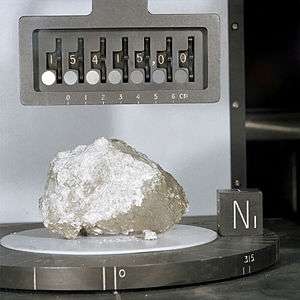
A sample-return mission is a spacecraft mission with the goal of collecting and returning tangible samples from an extraterrestrial location to Earth for analysis. Sample-return missions may bring back merely atoms and molecules or a deposit of complex compounds such as loose material ("soil") and rocks. These samples may be obtained in a number of ways, such as soil and rock excavation, mining, or a collector array used for capturing particles of solar wind or cometary debris.
Up to the present, humanity has collected samples of six identified Solar System bodies, as well as samples of the solar wind. These samples were acquired through three methods: The collection of samples of Earth itself, the collection of meteorites that have fallen on Earth, and the collection of samples through sample-return missions. Samples of Moon rock from Earth's Moon were collected both from meteorites and through robotic and crewed sample-return missions. The comet Wild 2 and the asteroid 25143 Itokawa were visited by robotic spacecraft, which returned samples to Earth. Furthermore, samples for three identified Solar System bodies were only collected by means other than sample-return missions: samples from Earth itself, samples from Vesta in the form of HED meteorites, and samples from Mars in the form of Martian meteorites.
Scientific use
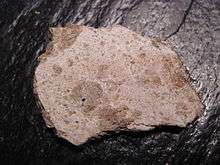
Samples available on Earth can be analyzed in laboratories, so we can further our understanding and knowledge as part of the discovery and exploration of the Solar System. Until now many important scientific discoveries about the Solar System were made remotely with telescopes, and some Solar System bodies were visited by orbiting or even landing spacecraft with instruments capable of remote sensing or sample analysis. While such an investigation of the Solar System is technically easier than a sample-return mission, the scientific tools available here on Earth to study such samples are far more advanced and diverse than those that can go on spacecraft. Analysis of samples on Earth allows to follow up any findings with different tools, including tools that have yet to be developed; in contrast, a spacecraft can carry only a limited set of analytic tools, and these have to be chosen and built long before launch.
Samples analyzed on Earth can be matched against findings of remote sensing, for more insight into the processes that formed the Solar System. This was done, for example, with findings by the Dawn spacecraft, which visited the asteroid Vesta from 2011 to 2012 for imaging, and samples from HED meteorites (collected on Earth until then), which were compared to data gathered by Dawn.[1] These meteorites could then be identified as material ejected from the large impact crater Rheasilvia on Vesta. This allowed deducing the composition of crust, mantle and core of Vesta. Similarly some differences in composition of asteroids (and, to a lesser extent, different compositions of comets) can be discerned by imaging alone. However, for a more precise inventory of the material on these different bodies, more samples will be collected and returned in the future, to match their compositions with the data gathered through telescopes and astronomical spectroscopy.
One further focus of such investigation—besides the basic composition and geologic history of the various Solar System bodies—is the presence of the building blocks of life on comets, asteroids, Mars or the moons of the gas giants. Several sample-return missions to asteroids and comets are currently in the works. More samples from asteroids and comets will help determine whether life formed in space and was carried to Earth in the form of meteorites. Another question under investigation is whether extraterrestrial life formed on other Solar System bodies like Mars or on the moons of the gas giants, and whether life might even exist there today. The result of NASA's last "Decadal Survey" was to prioritize a Mars sample-return mission, as Mars has a special importance: it is comparatively "nearby", might have harbored life in the past, and might even be able to sustain life today. Jupiter's moon Europa is another important focus in the search for life in the Solar System. However, due to the distance and other constraints, Europa might not be the target of a sample-return mission in the foreseeable future.
Planetary protection
Planetary protection aims to prevent biological contamination of both the target celestial body and the Earth—in the case of sample-return missions. No sample has yet been returned with alien life in it. A sample-return from Mars or other location with potential to host life, is a category V mission under COSPAR which directs to containment of any unsterilized sample returned to Earth. This is because it is unknown the effects of such hypothetical life would be on humans or on the biosphere of Earth.[2] For this reason, Carl Sagan and Joshua Lederberg argued in the 1970s that we should do sample-return missions classified as category V missions with extreme caution, and later studies by the NRC and ESF agreed.[2][3][4][5][6]
Sample-return missions
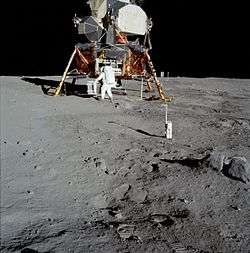
First missions
The manned US Apollo 11 mission in July 1969 achieved the first successful sample return from another Solar System body. It returned approximately 22 kilograms (49 lb) of Lunar surface material. This was followed by 34 kilograms (75 lb) of material from Apollo 12 and a further 326 kilograms (719 lb) of material from four more missions from the manned Apollo program.
Perhaps one of the most significant advances in sample-return missions occurred in 1970 when the robotic Soviet mission known as Luna 16 successfully returned 101 grams (3.6 oz) of lunar soil. Likewise, Luna 20 returned 55 grams (1.9 oz) in 1974, and Luna 24 returned 170 grams (6.0 oz) in 1976. Although they recovered far less than the Apollo missions, they did this fully automatically. Apart from these three successes, other attempts under the Luna programme failed. The first two missions were intended to outstrip Apollo 11 and were undertaken shortly before them in June and July 1969: Luna E-8-5 No. 402 failed at start, and Luna 15 crashed on the Moon. Later, other sample-return missions failed: Kosmos 300 and Kosmos 305 in 1969, Luna E-8-5 No. 405 in 1970, Luna E-8-5M No. 412 in 1975 at unsuccessful launches, and Luna 18 in 1971 and Luna 23 in 1974 at unsuccessful landings on the Moon.[7]
In 1970, the Soviet Union planned for a 1975 first Martian sample-return mission in the Mars 5NM project. This mission was planned to use an N1 rocket, but as this rocket never flew successfully, the mission evolved into the Mars 5M project, which would use a double launch with the smaller Proton rocket and an assembly at a Salyut space station. This Mars 5M mission was planned for 1979, but got canceled in 1977 due to technical problems and complexity; all hardware was ordered destroyed.[8]
New missions after a 20-year hiatus
NASA has a long-term stratospheric flight program to collect cosmic dust.[9][10][11]
The 1984 LDEF mission returned chondritic and iron-nickel impactors,[12] as did the 1992 EURECA mission.
The Earth-Orbital Debris Collection (ODC) experiment was deployed on the Mir space station for 18 months during 1996–1997 and used aerogel to capture particles from low Earth orbit, consisting of interplanetary dust and man-made particles. Far from being "the last sample-return mission... in... twenty years", ODC was a portable version of an LDEF collector, decreasing collection time significantly, and effective area by orders of magnitude.
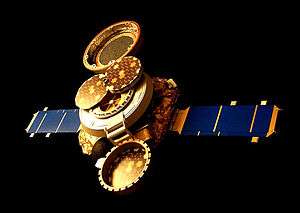
The next mission to return extraterrestrial samples was known as Genesis—it was able to return solar wind samples to Earth from beyond Earth orbit. Unfortunately, the Genesis capsule failed to open its parachute while re-entering the Earth's atmosphere and crash-landed in the Utah desert in 2004. There were fears of severe contamination or even total mission loss, but scientists have managed to save many of the samples, which were the first to be collected from beyond lunar orbit. Genesis used a collector array made of wafers of ultra-pure silicon, gold, sapphire, and diamond. Each different wafer was used to collect a different part of the solar wind.
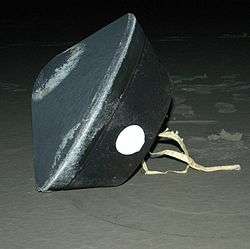
Genesis was followed by NASA's Stardust spacecraft, which returned comet samples to Earth on January 15, 2006. It safely passed by Comet Wild 2 and collected dust samples from the comet's coma while imaging the comet's nucleus. Stardust used a collector array made of low-density aerogel (99% of which is empty space), which has about 1/1000 of the density of glass. This permits the ability to collect the cometary particles without damaging them due to high impact velocities. Particle collisions with even slightly porous solid collectors would result in destruction of those particles and damage to the collection apparatus. During cruise, the second side of the array collected at least seven interstellar dust particles.[13]
In June 2010 the Japan Aerospace Exploration Agency (JAXA) Hayabusa probe returned asteroid samples to Earth after a rendezvous with (and a landing on) S-type asteroid 25143 Itokawa. In November 2010, scientists at the agency confirmed that, despite failure of the sampling device, the probe retrieved micrograms of dust from the asteroid, the first ever brought back to Earth in pristine condition.[14]
The Russian Fobos-Grunt was a failed sample-return mission that was supposed to return samples from Phobos, one of the moons of Mars. It was launched on November 8, 2011. However, the probe failed to leave Earth orbit and crashed after several weeks into the southern Pacific Ocean.[15][16]
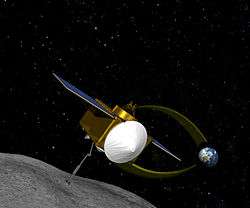
Current missions
The Japan Aerospace Exploration Agency (JAXA) launched the improved Hayabusa2 space probe on December 3, 2014 and plans to return asteroid samples by 2020. Hayabusa2 arrived at the target asteroid C-type asteroid 162173 Ryugu (formerly designated 1999 JU3) on 27 June 2018[17]. It is expected to survey the asteroid, which is a near-Earth asteroid, for a year and a half during which time it will collect samples multiple times, depart in December 2019, and return the samples to Earth in December 2020.[18]
The OSIRIS-REx mission was launched in September 2016 on a mission to return samples from the asteroid 101955 Bennu.[19][20] The samples are expected to enable scientists to learn more about the time before the birth of the Solar System, initial stages of planet formation, and the source of organic compounds that led to the formation of life.[21]
Future missions
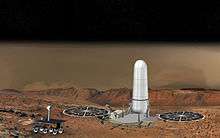
There were plans to launch a Mars Sample Return (MSR) mission in 2004, but following the twin-failures of the Mars Climate Orbiter and Mars Polar Lander, MSR was cancelled. NASA has long planned a Martian sample-return mission, but has yet to secure the budget to successfully design, build, launch, and land a probe that would do just that. There have been mission proposals in the past, but most have not made it far beyond the drawing boards. The mission remained on NASA's roadmap for planetary science as of the 2013 Planetary Science Decadal Survey.[23] A Mars sample-return mission in collaboration with Europe (as part of the Aurora programme) was proposed launch around 2018. Due to budget cuts at NASA, the future of this mission is uncertain.
China is planning to conduct a Chang'e 5 lunar sample return around 2019. If successful, it would make the first lunar sample return in over 40 years. Russia has plans for Luna-Grunt mission to return samples from the Moon by 2021 and Mars-Grunt to return samples from Mars 5–10 years later. Also, Russia plans to repeat Fobos-Grunt mission near 2024.
In September 2012, NASA announced concept studies on several strategies of returning a sample of Mars to Earth—including a multiple-launch scenario, a single-launch scenario and a multiple-rovers scenario—for a mission beginning as early as 2018.[24] JAXA is developing the MMX mission, a sample-return mission to Phobos that will be launched in 2024.[25] Of the two moons, Phobos's orbit is closer to Mars and its surface may have adhered particles blasted from the red planet; thus the Phobos samples collected by MMX may contain material originating from Mars itself.[26]
China has plans for a Mars sample-return mission by 2030.[27][28] Also, the Chinese Space Agency is designing a sample-retrieval mission from Ceres that would take place during the 2020s.[29]
Methods of sample return
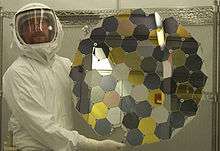
Sample-return methods include, but are not restricted to the following:
Collector array
A collector array may be used to collect millions or billions of atoms, molecules, and fine particulates by using a number of wafers made of different elements. The molecular structure of these wafers allows the collection of various sizes of particles. Collector arrays, such as those flown on Genesis, are ultra-pure in order to ensure maximal collection efficiency, durability, and analytical distinguishability.
Collector arrays are useful for collecting tiny, fast-moving atoms such as those expelled by the Sun through solar wind, but can also be used for collection of larger particles such as those found in the coma of a comet. The NASA spacecraft known as Stardust implemented this technique. However, due to the high speeds and size of the particles that make up the coma and the area nearby, a dense solid-state collector array was not viable. As a result, another means for collecting samples had to be designed as to preserve the safety of the spacecraft and the samples themselves.
Aerogel
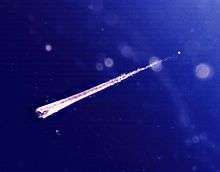
Aerogel is a silicon-based porous solid with a sponge-like structure, 99.8% of whose volume is empty space. Aerogel has about 1/1000 of the density of glass. An aerogel was used in the Stardust spacecraft because the dust particles the spacecraft was to collect would have an impact speed of about 6 km/s.[30] A collision with a dense solid at that speed could alter their chemical composition or perhaps vaporize them completely.
Since the aerogel is mostly transparent, and the particles leave a carrot-shaped path once they penetrate the surface, scientists can easily find and retrieve them. Since its pores are on the nanometer scale, particles, even ones smaller than a grain of sand, do not merely pass through the aerogel completely. Instead, they slow to a stop and then are embedded within it.
The Stardust spacecraft has a tennis-racket-shaped collector with aerogel fitted to it. The collector is retracted into its capsule for safe storage and delivery back to Earth. Aerogel is quite strong and easily survives both launching and outer-space environments.
Robotic excavation and return
Some of the most risky and difficult types of sample-return missions are those that require landing on an extraterrestrial body such as an asteroid, moon, or planet. It takes a great deal of time, money, and technical ability in order to even initiate such plans. It is a difficult feat that requires that everything from launch to landing to retrieval and launch back to Earth be planned out with high precision and accuracy.
This type of sample return, although having the most risks, is the most rewarding for planetary science. Furthermore, such missions carry a great deal of public outreach potential, which is an important attribute for space exploration when it comes to public support. The only successful robotic sample-return missions of this type have been the Soviet Luna landers.
List of missions
Crewed missions
| Launch date | Operator | Name | Sample origin | Samples returned | Recovery date | Mission result |
|---|---|---|---|---|---|---|
| 16 July 1969 | Apollo 11 | Moon | 22 kilograms (49 lb) | 24 July 1969 | Successful | |
| 14 November 1969 | Apollo 12 | Moon | 34 kilograms (75 lb) | 24 November 1969 | Successful | |
| 11 April 1970 | Apollo 13 | Moon | — | 17 April 1970 | Failed | |
| 31 January 1971 | Apollo 14 | Moon | 43 kilograms (95 lb) | 9 February 1971 | Successful | |
| 26 July 1971 | Apollo 15 | Moon | 77 kilograms (170 lb) | 7 August 1971 | Successful | |
| 16 April 1972 | Apollo 16 | Moon | 95 kilograms (209 lb) | 27 April 1972 | Successful | |
| 7 December 1972 | Apollo 17 | Moon | 111 kilograms (245 lb) | 19 December 1972 | Successful | |
| 22 March 1996 | Earth-Orbital Debris Collection | Low Earth orbit | Particles | 6 October 1997 | Successful[31] | |
| 14 April 2015 | Tanpopo mission | Low Earth orbit | Particles | February 2018[32] | Successful |
Robotic missions
| Launch date | Operator | Name | Sample origin | Samples returned | Recovery date | Mission result |
|---|---|---|---|---|---|---|
| 14 June 1969 | Luna E-8-5 No. 402 | Moon | Failure | |||
| 13 July 1969 | Luna 15 | Moon | Failure | |||
| 23 September 1969 | Cosmos 300 | Moon | Failure | |||
| 22 October 1969 | Cosmos 305 | Moon | Failure | |||
| 6 February 1970[7] | Luna E-8-5 No. 405 | Moon | Failure | |||
| 12 September 1970 | Luna 16 | Moon | 101 grams (3.6 oz) | 24 September 1970 | Success | |
| 2 September 1971 | Luna 18 | Moon | Failure | |||
| 14 February 1972 | Luna 20 | Moon | 55 grams (1.9 oz) | 25 February 1972 | Success | |
| 2 November 1974 | Luna 23 | Moon | Failure | |||
| 16 October 1975 | Luna E-8-5M No. 412 | Moon | Failure | |||
| 9 August 1976 | Luna 24 | Moon | 170 grams (6.0 oz) | 22 August 1976 | Success | |
| 7 February 1999 | Stardust | 81P/Wild | Particles | 15 January 2006 | Success | |
| 8 August 2001 | Genesis | Solar wind | Particles | 9 September 2004 | Success (partial) | |
| 9 May 2003 | Hayabusa | 25143 Itokawa | Particles | 13 June 2010 | Success (partial) | |
| 8 November 2011 | Fobos-Grunt | Phobos | Failure | |||
| 3 December 2014 | Hayabusa2 | 162173 Ryugu | December 2020 | Ongoing | ||
| 8 September 2016 | OSIRIS-REx | 101955 Bennu | 2023 | Ongoing | ||
| 2019 | Chang'e 5 | Moon | 2019 | Planned | ||
| 2024 | MMX | Phobos | 2029 | Planned |
Comet sample return
Various comets have been studied for sample return including:[33] The Stardust mission returned coma samples, Deep Impact collided with a nucleus, and Rosetta's lander landed, but to date no sample return mission has been conducted. Scavenging space dust for comet debris
- 9P/Tempel 1 (Deep Impact target)
- 19P/Borrelly (DS1 target)
- 81P/Wild 2 (Stardust target)
- 67P/Churyumov–Gerasimenko (Rosetta target and possibly also CAESAR propoal)
- 21P/Giacobini-Zinner (ICE target)
- 22P/Kopff (CRAF target (not launched))
- 6P/d'Arrest (in-fulfilled target of the lost CONTOUR)
- 43P/Wolf-Harrington
- 46P/Wirtanen (former target of Rosetta)
See also
References
- ↑ What did Dawn learn at Vesta? The Planetary Society.
- 1 2 Joshua Lederberg Parasites Face a Perpetual Dilemma (PDF). Volume 65, Number 2, 1999 / American Society for Microbiology News 77.
- ↑ Assessment of Planetary Protection Requirements for Mars Sample Return Missions (Report). National Research Council. 2009.
- ↑ Preliminary Planning for an International Mars Sample Return Mission Report of the International Mars Architecture for the Return of Samples (iMARS) Working Group June 1, 2008.
- ↑ European Science Foundation – Mars Sample Return backward contamination – Strategic advice and requirements Archived 2016-06-02 at the Wayback Machine. July, 2012, ISBN 978-2-918428-67-1 – see Back Planetary Protection section. (for more details of the document see abstract).
- ↑ Mars Sample Return: Issues and Recommendations. Task Group on Issues in Sample Return. National Academies Press, Washington, DC (1997).
- 1 2 Wade, Mark. "Luna Ye-8-5". Encyclopedia Astronautica. Retrieved 27 July 2010.
- ↑ Советский грунт с Марса (in Russian) Archived April 8, 2010, at the Wayback Machine.
- ↑ Hodges, P. (1961). "Sampling Dust from the Stratosphere". Smithsonian Contributions to Astrophysics. 5: 145. Bibcode:1961SCoA....5..145H. doi:10.5479/si.00810231.5-10.145.
- ↑ Warren, J.; Zolensky, M. (1994). "Collection and curation of interplanetary dust particles recovered from the stratosphere". AIP Conference Proceedings. 310. doi:10.1063/1.46514.
- ↑ Testa, J. (1990). "Collection of microparticles at high balloon altitudes in the stratosphere". Earth and Planetary Science Letters. 98 (3–4): 287. Bibcode:1990E&PSL..98..287T. doi:10.1016/0012-821X(90)90031-R.
- ↑ Oliver, J. art al. (1995). "LDEF Interplanetary Dust Experiment (IDE) results". Long duration exposure flight (LDEF) symposium.
- ↑ Westphal, A.; Stroud, R.; et al. (15 Aug 2014). "Evidence for interstellar origin of seven dust particles collected by the Stardust spacecraft". Science. 345 (6198): 786. Bibcode:2014Sci...345..786W. doi:10.1126/science.1252496. PMID 25124433.
- ↑ Amos, Jonathan (November 16, 2010). "Japan probe collected particles from Itokawa asteroid". BBC News. Retrieved November 16, 2010.
- ↑ Emily Lakdawalla (January 13, 2012). "Bruce Betts: Reflections on Phobos LIFE". The Planetary Society Blog. Retrieved March 17, 2012.
- ↑ Kramer, Andrew (January 15, 2012). "Russia's Failed Mars Probe Crashes Into Pacific". Retrieved January 16, 2012.
- ↑ "Japanese spacecraft reaches asteroid after three-and-a-half-year journey – Spaceflight Now". spaceflightnow.com. Retrieved 2018-09-23.
- ↑ "Operation Status for the Asteroid Explorer Hayabusa2, in the vicinity of Ryugu" (PDF). global.jaxa.jp. 19 July 2018. Retrieved 22 September 2018.
- ↑ "NASA's OSIRIS-REx Speeds Toward Asteroid Rendezvous". NASA. 9 September 2016. Retrieved 9 September 2016.
- ↑ "Asteroid probe begins seven-year quest". BBC News. 9 September 2016. Retrieved 9 September 2016.
- ↑ "NASA To Launch New Science Mission To Asteroid In 2016". NASA.
- ↑ "Archived copy" (PDF). Archived from the original (PDF) on 2016-12-22. Retrieved 2017-12-29.
- ↑ Visions and Voyages for Planetary Science in the Decade 2013–2022, National Academies Press.
- ↑ Wall, Mike (September 27, 2012). "Bringing Pieces of Mars to Earth: How NASA Will Do It". Space.com. Retrieved September 28, 2012.
- ↑ "Martian Moons eXploration (MMX) Mission Overview" (PDF). JAXA Tokyo Office: JAXA. 10 April 2017. Retrieved 2018-07-20.
- ↑ "火星衛星の砂回収へ JAXA「フォボス」に探査機". Nikkei (in Japanese). September 22, 2017. Retrieved 2018-07-20.
- ↑ English.news.cn (2012-10-10). "China considers more Mars probes before 2030". news.xinhuanet.com. Retrieved 2012-10-14.
- ↑ Staff Writers Beijing (AFP) (2012-10-10). "China to collect samples from Mars by 2030: Xinhua". marsdaily.com. Retrieved 2012-10-14.
- ↑ China's Deep-space Exploration to 2030 by Zou Yongliao Li Wei Ouyang Ziyuan Key Laboratory of Lunar and Deep Space Exploration, National Astronomical Observatories, Chinese Academy of Sciences, Beijing.
- ↑ "Stardust, NASA's Comet Sample Return Mission". NASA. Retrieved 11 December 2015.
- ↑ "Mir Orbital Debris Collector Data Analyzed". Spacedaily.com. Retrieved 8 July 2018.
- ↑ https://www.nasa.gov/mission_pages/station/research/experiments/2201.html
- ↑ "Archived copy" (PDF). Archived from the original (PDF) on 2018-05-31. Retrieved 2017-12-29.
External links
- Mars Exploration: Sample Returns Jet Propulsion Laboratory Mars Exploration Program on sample return missions.
- Stardust Homepage Jet Propulsion Laboratory Stardust mission website.
- Genesis Mission Homepage Jet Propulsion Laboratory Genesis mission website.
- Stardust: Aerogel Stardust website on aerogel technology.
- JAXA Hayabusa JAXA Hayabusa project update.
- MarsNews.com: Mars Sample Return MarsNews.com on Mars Sample Return missions.
- Texas Space Grant Consortium: Missions to the Moon A list of missions to the Moon from 1958 to 1998.
- Evaluating the Biological Potential in Samples Returned from Planetary Satellites and Small Solar System Bodies The National Academies, Space Science Board 1998
.jpg)